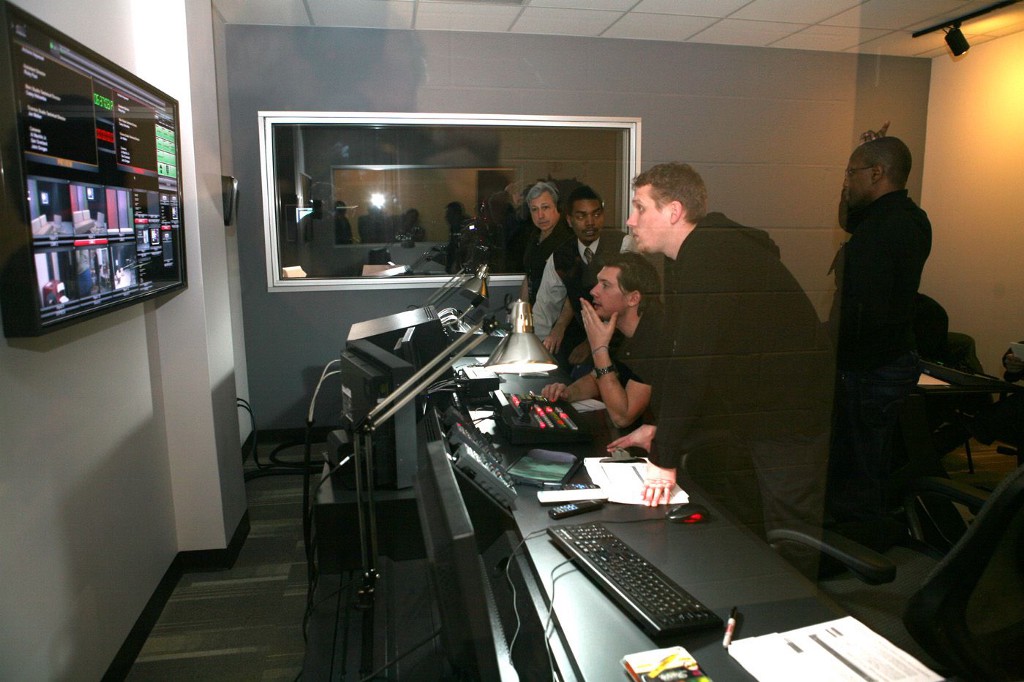
The thing about TV is that it’s an instant medium, or so we believe. That wasn’t the case for public access TV in Philly. That took a while — almost three decades.
But it’s here at last.
PhillyCAM, which broadcasts on Comcast channels 66 and 966 and Verizon’s 29 and 30, opened its studios and headquarters at 699 Ranstead St. in Center City last week.
“You’re on TV!” PhillyCAM’s executive director Gretjen Clausing told a crowd of public access advocates and lawmakers as cameras rolled at the new facility on Feb. 8.
Giving the public free access to cable channels was part of the original franchise agreements with the city’s first cable companies, Clausing said in a Feb. 9 phone interview. The money to pay for equipment and broadcasting was to come from the franchise fees cable companies charged their subscribers. That cash money got collected, but it went into the city’s treasury, she said.
Ordinary people making their own, uncensored programs remained an idea and not a reality for more than 25 years, Clausing said.
Why?
“I don’t think there was one single reason,” Clausing said.
First, there was a gap in leadership on the issue. Mayor Michael Nutter, who spoke at the Feb. 8 PhillyCAM event, said Councilman at-large John Anderson had been the biggest advocate for the mid-1980s cable legislation.
But Anderson died in office and no one replaced him on the issue, Clausing said.
Then, it became a budgetary question and after that, she said, the issue was misunderstood by some elected officials who thought public access TV would be little more than an outlet for pornography and hate speech.
A few years ago, public access TV advocates starting renewing the push to get on the air. In 2007, she said, the Philadelphia Community Access Coalition and city officials were able to revise the cable franchise agreement with Comcast. But advocates also convinced city residents of the relevance of public access.
“What began to turn the tide,” she said, “is when people began to see the consolidation of the media, that access to alternative points of view was shrinking.”
Then, finally, a few years ago, public access TV became a reality.
“We went on the air in 2009,” she said, but there were no studios and “our broadcast server was in City Hall. … We were sharing rack space with the government.”
The shows PhillyCAM broadcast were produced independently and handed in by those who created and shot the programs.
Unsolved Philadelphia, which focuses on the city’s unsolved homicides, is one of those programs, Clausing said. Produced by Grady Jones, who spoke briefly at the Feb. 8 event, it “gives an incredible measure of closing to murder victim’s families,” Clausing said.
Free speech is the overriding idea behind public access TV, Clausing said. The shows PhillyCAM will air are not censored, she said, so, the hate speech and pornography that politicians feared would not be censored either.
“But if you look at the history of public access, the number of those incidents are small,” she said.
In Philadelphia, 70 percent of the population still gets most news from TV, not newer media like the Internet or smart phones. Providing channels on which residents can share neighborhood information or have long conversations about specific issues is “incredibly powerful,” Clausing said.
That power is easy to tap.
To get a show on the air, you have to join PhillyCAM. That’s $25. Then you take a training class on how to use digital video, get tested on what you’ve learned and then you’re certified to reserve and use PhillyCAM’s equipment. The show you make must end up on the public access channel. If you want to get a regular weekly time spot, you must turn in at least one new show per month, Clausing said. You can take other courses to get studio and editing skills, too, she said.
Currently, there are no programs that originate or concentrate on Northeast Philly.
Interested in changing that? Go to www.phillycam.org ••

